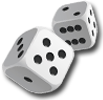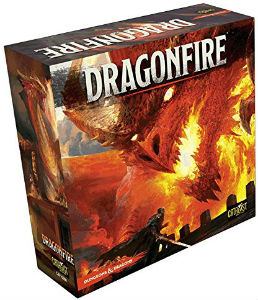



play board games
Board game reviews, strategy tips & session reports
Dragonfire Board Game Review
 Stats:
Stats:
No. of players: 2-6
Amount of time to play: 60-90 min
Age requirements: 13+
Set-up time: 5 min
Dragonfire is a cooperative deck building game with a Dungeons and Dragons theme. Your party of adventurers must defeat encounters to win and gain XP and level up.
Dragonfire Rules Description:
To start Dragonfire you must pick which character you want to. Characters come in four classes, warrior, rogue, cleric and wizard. There are both male and female represented and you can even choose between different races. Depending on which character you choose you will get a different starting deck, gold and health.
This game is scenario based and depending on the scenario you add different monsters to the encounter decks. The scenario card tells you how many encounters to reveal based in the number of players. Each encounter has a background color that matches one on the classes. The first encounter flipped is placed in front of the character with its matching color. Then the rest are distributed in clock-wise order from there.
The Dragonfire deck is full of events that might help but usually harm you. At the start of the first player’s turn they draw a card from this deck every round and read it aloud. Some encounters and other Dragonfire cards gain power based on the number of Dragonfire cards you have drawn.
On your turn you play cards to attack any encounter in front of any character. The encounters have a damage track on the lower right-hand side of the card. It tells you which type and the amount of damage you need to play to defeat the encounter. You start at the top of the track and work your down. The type of damage is determined by its color and symbol which relates to each character class. Some cards have the assist keyword. These may be played for their assist effect when it isn’t your turn. When you defeat an encounter you gain its gold value. Gold is distributed one piece at a time in clockwise order, starting with the current player.
One encounter type does add a wrinkle to what I said above. Locations are encounters that separate you from the rest of the party. You cannot attack or assist another player’s encounter when you have a location encounter in front of you. In order to attack a location encounter in front of another player you must move to their location. You can always assist any player if you don’t have a location in front of you.
Any encounters still in front of you after you attack damage you. Each encounter has a damage value and you deduct this from your current health. If your health drops to zero you become stunned. This makes you discard your hand, shuffle all your cards, and draw one. Going forward you only draw one card every turn and cannot buy new cards. Getting hit while stunned knocks you unconscious. You no longer take turns but can be healed later.
Next if you have three or less cards, you draw two cards from your deck. If you have more cards you only draw one. Then you may buy a card from the six in the market. Cards you buy are added to your hand and if you don’t buy one you must cycle one currently in the market.
Once you defeat all the encounters in front of all players you get a short rest. This lets everyone buy another card and gain one health.
Each scenario is split into three scenes with each scene becoming a bit tougher. If all three scenes are completed without the entire party being unconscious you win. Winning gets you some XP with which you can gain additional abilities and items.
Quick Review of Dragonfire:
Dragonfire is a fun cooperative deck building game that includes a campaign mode. It can be random but as you will enjoy building your deck and growing your character.
The components for this game are great. The cards are durable and have some really nice artwork. The rulebook is long but pretty easy to follow. The quick-start guide is not super useful though. It has some different rules, is meant for four players and doesn’t give a good representation of the full game. I’d skip it and go straight to the full game rules.
The campaign mode makes this game. I play Dungeons and Dragons and one of the most satisfying parts is seeing your character grow and change. In Dragonfire it is enjoyable too.
I like that cards you buy go directly into your hand. It makes the buy phase more strategical and it feels like it matters more. You are buying a card to use on your next turn or to assist someone else. Not putting it in your discard pile and hoping it shows up soon.
Some cooperative games suffer from quarterbacking. But with separate hands it is easy to avoid here. That said if you are playing with kids or new players you have the ability to share more information and coach more.
The box says two to six players but it doesn’t scale down very well. I tries it several times with two players and never won. I think it plays best with three or four.
If your game group is looking for a fun deck-builder to play through as a campaign, pick Dragonfire up. If you enjoy deck building games, DnD, or fantasy setting, give it a try.
Score and synopsis: (Click here for an explanation of these review categories.)
Strategy 3 out of 6
Luck 5 out of 6
Player Interaction 5 out of 6
Replay Value 5 out of 6
Complexity 3 out of 6
Fun 4 out of 6
Overall 4 out of 6

Leave a Reply